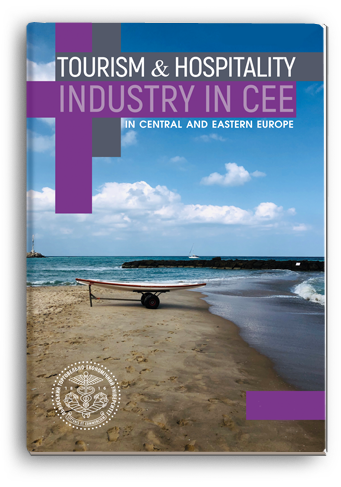Анотація
У статті досліджено потенціал екологічного туризму в регіонах України на основі тестування екологічних кривих Кузнеця (ЕКК), побудованих через співвідношення викидів в атмосферне повітря на кв. км регіону та валового регіонального продукту на душу населення. Показником туристичного потенціалу регіону вибрано валову додану вартість за такими видами економічної діяльності, як мистецтво, спорт, розваги та відпочинок і тимчасове розміщення та організація харчування (за період 2005–2018 рр. у приведених цінах). За наведеним показником вибрано Дніпропетровську, Львівську, Одеську області, як такі, що мають найвищу частку ВДВ за зазначеними видами економічної діяльності, а також побудовано ЕКК за даними в середньому по Україні. Більш ранній період проходження поворотної точки ЕКК в регіоні дає змогу зробити висновок про стійкість тенденції до екологічної переорієнтації населення. Доведено, що екотуризм має перспективи розвитку лише після досягнення певного рівня валового регіонального продукту і, відповідно, отримання населенням певного рівня прибутку, який і дає змогу поширитися стійким «зеленим» тенденціям у сфері організації відпочинку. За результатами дослідження зроблено висновок, що Дніпропетровська та Львівська області, а також Україна загалом пройшли поворотну точку на початку другої половини досліджуваного періоду (2012–2015 рр.), і лише Одеська область характеризується найбільш стійкими тенденціями до екологізації туризму у зв’язку з проходженням поворотної точки ЕКК у 2009 р. Тенденції ЕКК для Львівської області збігаються із середніми по Україні. Особливості ЕКК Дніпропетровської області зумовлені вищим рівнем ВРП на душу населення, який відображає проходження поворотної точки ЕКК (44 650 грн на душу населення проти середнього показника по Україні 32 002 грн на душу населення). Відповідно, доведено наявність соціальних та ринкових передумов для активного розвитку екологічного туризму в Україні та найбільших її туристичних регіонах. Перспективи подальших досліджень полягають у підвищенні специфікації ЕКК через розширення переліку викидів шкідливих речовин, а також конкретизації напрямів регіональної екологічної політики у сфері стимулювання та поширення екотуризму.
Посилання
Björk P. Ecotourism from a conceptual perspective, anex tendeddefinition of a unique tourism form. International Journal of Tourism Research. 2000. Vol. 2. P. 189–202.
Blamey R. Ecotourism: the search for an operational definition. Journal of Sustainable Tourism. 1997. Vol. 5(2). P. 109–130. DOI: https://doi.org/10.1080/09669589708667280
Buckley R. A framework for ecotourism. Annals of Tourism Research. 1994. Vol. 21(3). P. 661–665.
Cater E. Ecotourismas a Western Construct. Journal of Ecotourism. 2006. Vol. 5(1–2). P. 23–39. DOI: https://doi.org/10.1080/14724040608668445
Fennell D. A. A Content Analysis of Ecotourism Definitions. Current Issuesin Tourism. 2001. Vol. 4(5). P. 403–421. DOI: https://doi.org/10.1080/13683500108667896
Horoshkova L., Khlobystov Іe., Filipishyna L., Shvydenko M., Bessonova S. Economic and mathematical modeling of ecological expenditure for sustainable development of united territorial communities. Monitoring of Geological Processes and Ecological Condition of the Environment: proceed. of XIV Int. Scient. Conf., Nov. 2020. Vol. 2020. P. 1–5. DOI: https://doi.org/10.3997/2214-4609.202056091
Kong Y., Khan R. To examine environmental pollution by economic growth and their impact in an environmental Kuznets curve (EKC) among developed and developing countries. PLoS ONE. 2019 Vol. 14(3). DOI: https://doi.org/10.1371/journal.pone.0209532
Кубатко О. В., Лук`яненко В. В., Могиленець Т. В. Економiко-математичнi пiдходи до моделювання процесiв сталого розвитку територiй. Механізм регулювання економіки. 2010. № 2. С. 193–199.
Lopatnikov D. Environmentally positive trends on the world map in the first two decades of the XXI century: geography, factors and prospects. Geographical Environment and Living Systems. 2020. № 2. Р. 18–27. DOI: https://doi.org/10.18384/2712-7621-2020-2-18-27
Richardson, R. The Role of Tourism in Sustainable Development. Oxford Research Encyclopedia of Environmental Science. URL: https://oxfordre.com/environmentalscience/view/10.1093/acrefore/9780199389414.001.0001/acrefore-9780199389414-e-387
Валовий регіональний продукт (2004–2019). Укрстат. 2019. URL: http://www.ukrstat.gov.ua/operativ/operativ2021/-vvp/kvartal_new/vrp/arh_vrp_u.html.
Виробництво та розподіл валового внутрішнього продукту за видами економічної діяльності. Укрстат. 2020. URL: https://ukrstat.org/uk/operativ/operativ2008/vvp/vvp_ric/arh_vtr_u.htm.
Shapoval V., Bondarenko L., Ways to overcome the crisis in the tourism sector under quarantine restrictions. Таврійський науковий вісник. Серія «Економіка». 2021. № 8. С. 15–21. DOI: https://doi.org/10.32851/2708-0366/2021.8.2
Björk, P. (2000), Ecotourism from a conceptual perspective, anex tendeddefinition of a unique tourism form, International Journal of Tourism Research, vol. 2, pp. 189–202.
Blamey, R. (1997), Ecotourism: the search for an operational definition, Journal of Sustainable Tourism, 5(2), 109–130. DOI: https://doi.org/10.1080/09669589708667280
Buckley, R. (1994), A framework for ecotourism, Annals of Tourism Research, vol. 21(3), pp. 661–665.
Cater, E. (2006), Ecotourismas a Western Construct, Journal of Ecotourism, vol. 5(1–2), pp. 23–39. DOI: https://doi.org/10.1080/14724040608668445
Fennell, D. A. (2001), A Content Analysis of Ecotourism Definitions, Current Issuesin Tourism, vol. 4(5), pp. 403–421. DOI: https://doi.org/10.1080/13683500108667896
Horoshkova, L., Khlobystov, Іe., Filipishyna, L., Shvydenko, M. And Bessonova, S. (2020), Economic and mathematical modeling of ecological expenditure for sustainable development of united territorial communities, XIV International Scientific Conference “Monitoring of Geological Processes and Ecological Condition of the Environment”.
European Association of Geoscientists & Engineers Source, Nov. 2020, vol. 2020, pp. 1–5. DOI: https://doi.org/10.3997/2214-4609.202056091
Kong, Y., Khan, R. (2019), To examine environmental pollution by economic growth and their impact in anenvironmental Kuznetscurve (EKC) among developed and developing countries, PLoS ONE, vol. 14(3). DOI: https://doi.org/10.1371/journal.pone.0209532 (accessed 04 November 2021).
Kubatko, O., Lukyanenko, V., Mohylenets, T. (2010), “Economic and mathematical approaches to modeling the processes of sustainable development of territories”, Mekhanizm rehulyuvannya ekonomiky, no. 2, pp. 193–199.
Lopatnikov, D. (2020), Environmentally positive trends on the world map in the first two decades of the XXI century: geography, factors and prospects, Geographical Environment and Living Systems, no. 2, pp. 18–27. DOI: https://doi.org/10.18384/2712-7621-2020-2-18-27
Richardson, R. (2021), The Role of Tourismin Sustainable Development, Oxford Research Encyclopedia of Environmental Science [Online], available at: https://oxfordre.com/environmentalscience/view/10.1093/acrefore/9780199389414.001.0001/acrefore-9780199389414-e-387 (accessed 04 November 2021).
Ukrstat (2019), “Grossregional product (2004-2019)”, available at: http://www.ukrstat.gov.ua/operativ/operativ2021/vvp/kvartal_new/vrp/arh_vrp_u.html (accessed 04 November 2021).
Ukrstat (2020), “Production and distribution of gross domestic product by type of economic activity”, available at: https://ukrstat.org/uk/operativ/operativ2008-/vvp/vvp_ric/arh_vtr_u.htm (accessed 04 November 2021).
Shapoval, V., Bondarenko, L. And Bieloborodova, M. (2021), “Ways to overcome the crisis in the tourism sector under quarantine restrictions”, Tavriysʹkyy naukovyy visnyk. Seriya: Ekonomika, no. (8), pp. 15–21. DOI: https://doi.org/10.32851/2708-0366/2021.8.2.


